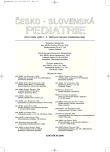Food Supplements with Fish Oils – The Composition of Fatty Acids
Authors:
E. Tvrzická; B. Staňková; M. Vecka; A. Žák
Authors‘ workplace:
4. interní klinika 1. LF UK a VFN, Praha
přednosta prof. MUDr. A. Žák, DrSc.
Published in:
Čes-slov Pediat 2006; 61 (9): 513-518.
Category:
Original Papers
Overview
Objective:
Polyunsaturated fatty acids of n-3 series are essential nutrients and the organism is dependent on their intake in food. If their intake is insufficient it is suitable to compensate it by special food supplements. These supplements are often used as supportive preparation in the therapy of hyperlipoproteinemia, obesity, diabetes mellitus type 2 and procoagulation states; they are also included in enteral and parenteral nutrition (here playing a role in supportive therapy of critical states). In the distribution network of pharmacies there is a series of these kinds of preparations, which differ in representation of active components – eicosapentaene and docosahexaene acids, respectively. The aim of this study was to compare individual preparations in view of the composition of fatty acids.
Methods:
The composition of fatty acids was determined by capillary gas chromatography after their derivatization to methyl esters by direct transmethylation.
Results:
The composition of fatty acids in food supplements depends on the source. Most preparations contain more than 30 mol % of polyunsaturated fatty acids n-3, only in three of the content was less than 20 mol %. In two preparations the content of the efficient components exceeded 60 mol %, in one of them 95 mol % as a consequence of removal of saturated and unsaturated fatty acids. In contrast, nine preparations contained almost 10 mol % of myristic acid.
Conclusions:
In dosing of the preparation it is necessary to consider the actual content of more unsaturated fatty acids in order to reach the required effect. Another factor to consider is the content of saturated fatty acids, especially that of myristic acid which is undesirable due to its lipogenic action.
Key words:
polyunsaturated fatty acids n-3, metabolism of lipids, dyslipidemia, malnutrition
Labels
Neonatology Paediatrics General practitioner for children and adolescentsArticle was published in
Czech-Slovak Pediatrics

2006 Issue 9
Most read in this issue
- Primary Disorders of Lipid Metabolism in Children – Our Experience
- Does Artificial Suckling Nutrition Pose a Risk of Atherosclerosis at the Adult Age?
- Food Supplements with Fish Oils – The Composition of Fatty Acids
- National Cholesterol Program in Children’s Population in Slovakia and Its Contribution
